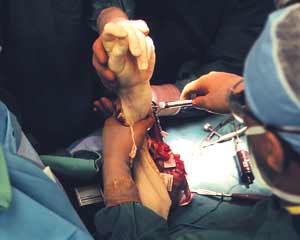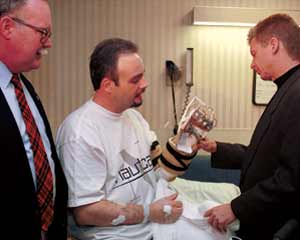Hand transplant patients experience both success, failure
Over the last five years, there have been 14 confirmed hand transplants; two transplants have been removed.
In September 1998, a team of surgeons in Lyon, France, performed the world’s first successful hand-forearm transplants. Since then, there have been 18 reported unilateral or bilateral transplants but only 14 have been confirmed.
W.P. Andrew Lee, MD, visited six centers around the world where those 14 transplants were performed and evaluated 11 transplant recipients as part of the Sterling Bunnell Traveling Fellowship. “Limited functional returns have been observed, but any effect of chronic rejection on the function is too early to determine,” said Lee, chief of plastic surgery at the University of Pittsburgh Medical Center.
“I came away from my trips more convinced that hand transplantation stands to benefit the lives of patients and their families, yet its future belongs in further research that will achieve better function and minimize systemic immunosuppression.” Lee gave his presentation at the 58th Annual Meeting of the American Society for Surgery of the Hand in Chicago.
Highest number in 2000
|
|
Lee said that the highest number of hand transplants was performed in 2000. All transplant recipients were men; their age at the time of transplant ranged from 21 to 46. Five received bilateral transplants, and of the nine unilateral transplants, seven replaced the right dominant hand and two replaced the left hand.
The time interval between patient injury and transplant ranged from one to 15 years with a median of four years. The majority of the amputations were done at the distal forearm, although the most recent transplant was done at a level close to the elbow.
The longest surviving transplanted hand, now at 4½ years, belongs to American Matthew David Scott, a father of two who is a paramedic instructor. He lost his hand when a powerful firecracker exploded while he was holding it. Warren C. Breidenbach, MD, a hand surgeon with Kleinert, Kutz and Associates Hand Care Center in Louisville, U.S.A., headed the team that performed Scott’s transplant.
“[Scott] told me that the biggest benefit of hand transplant for him was body image, and he gave me a recent example of being able to applaud his son at a karate contest,” Lee said.
Transplant removals
|
COURTESY OF JEWIH HOSPITAL, KLEINERT KUTZ AND ASSOCIATES HAND CARE CANTER AND THE UNIVERSITY OF LOUISVILLE |
The outcome for Australian Clint Hallam, the world’s first successful hand transplant recipient, was not as positive. Hallam received his transplant in Lyon from a team headed by Jean Michel Dubernard, MD. While the procedure was initially a success, the hand was removed after rejection that was attributed to the patient’s lack of compliance in taking medication and performing therapy. “The rejected hand was eventually removed, with evidence of severe skin necrosis,” Lee said.
The reason for removal of a transplanted hand in China is less clear, Lee said. The transplant developed a severe rash refractory to steroids and antifungal agents. The patient then received subcutaneous cortisone injections that apparently resulted in vessel thrombosis and severe ischemic pain necessitating transplant removal. “Despite his initial good functional return, the patient told me that he would not undergo another hand transplant,” Lee said.
Surgical complications have included two cases of vascular thrombosis that required further surgery, and at least two patients developed necrosis in the transplanted hand and forearm requiring skin graft. At least four patients required tenolysis, and one patient developed osteomyelitis of the ulna with positive bone cultures and required removal of the fixation plate despite lack of radiographic union.
Returned to work
Despite those complications, nine of 12 transplant recipients have returned to modified jobs, and of those who have had their transplanted hand for more than a year, all but one have returned to work. Of the unilateral recipients, four cited body image and improved ability to engage in social interactions as the greatest benefit of their hand transplant. Four cited increased hand function, and two cited greater self-reliance, Lee said.
The bilateral hand transplant recipients listed different benefits. “Two cited the ability to feel their world, including touching their wives and children, and three cited greater self-reliance as their most significant benefit,” Lee said.
When asked about disappointments with the procedure, four patients said they had none, four cited less function than they had hoped for, three cited side effects from medication, and two mentioned the length of recovery and rehabilitation.
“There were successes and failures,” Lee said. “No serious adverse effects have been encountered from the immunosuppression, yet additional medications were required in some cases with unknown long-term efficacy or side effects.”
For more information:
- Lee WPA. Sterling Bunnell Traveling Fellowship Lecture. Presented at the 58th Annual Meeting of the American Society for Surgery of the Hand. Sept. 18-20, 2003. Chicago.


